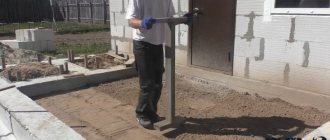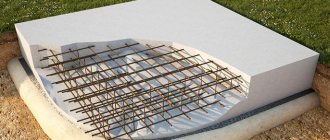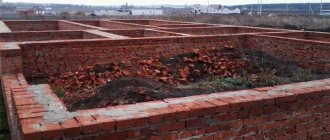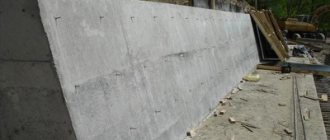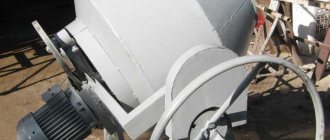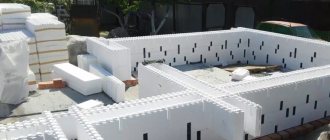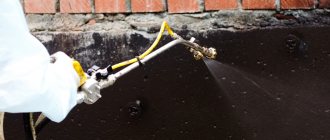Plasticizers for cement mortars on sale
Plasticizers can be made from mineral, organic or inorganic substances. The most common commercially available formulations include:
ArmMix Superplast (Russia). Belongs to the class of superplasticizers. Water-based from organic and inorganic salts for interior and exterior use. Can be used for masonry, foundation mortars, foam and fiber-reinforced concrete, production of mixtures for floor screed, paving and facade slabs. Suitable for mortars and concrete of any grade. Consumption: 0.2% by weight of cement.
Saponified wood resin. Superplasticizer. A composition with a water-repellent effect obtained as a result of the hydrolysis of esters of deciduous and coniferous wood. It is a foaming agent and forms a large number of air bubbles, reducing density. Used in the production of lightweight concrete, expanded clay concrete, foam concrete, etc. Increases mobility, frost resistance and thermal insulation properties. Concrete based on it allows less moisture to pass through. Consumption 0.1-0.3%.
Superplasticizer S-3. One of the frequently used inexpensive plasticizers. The composition contains naphthalene-formaldehyde sulfate. Improves the service life of concrete structures, including cement plasters. When introduced into a sand-cement mortar, it reduces its delamination, increases fluidity and mobility. Low consumption. 100 kg of cement requires 5-7 kg
Mplus. Liquid mixture based on a complex of salts. It increases not only plasticity, but also density, resistance to physical stress, uniformity of concrete and slows down its setting. Reduces cement consumption. Used in mortars for pouring and screeding floors. Consumption 1 liter per 100 kg of dry cement.
Mapei Planicrete. The main component is synthetic rubber. Increases plasticity, mobility, ability to retain moisture, adhesion to the surface of the solution and its strength. For external and internal works. Consumption may vary depending on the purpose of the cement-sand mixture and is 200-300 kg/sq. m.
Why do you need a plasticizer for concrete?
So, such an additive for concrete can be described in different ways, but the most common version of its meaning, the following one, is a plasticizer, the substance of which is a polymer, thanks to which the materials will have elasticity, and working with cement mortar will be a pleasure.
There will be no problems finding plasticizers at points of sale of building materials, but at the same time, its cost cannot be called affordable, and the purchase can hit the budget very hard.
In order to understand what kind of concrete additive this is, let’s look at its quality characteristics:
- thanks to the addition of a plasticizer to the cement mortar, laying it in various forms becomes simplified (saving time and effort);
- the mobility of the solution becomes greater;
- moisture does not get into it, which means the humidity level is minimal;
- the adhesion of the mixture and reinforcement becomes stronger;
- fluid consumption in construction processes is reduced;
- the presence of a plasticizer increases the shelf life of concrete;
It turns out that the process of working with cement, in the presence of the mixture in question, becomes much simpler and more efficient.
DIY plasticizers for cement mortars
In order for the cement mortar to have better performance characteristics, craftsmen add special chemical plasticizers to them. Thanks to them, the solution becomes more elastic, frost-resistant and acquires water-repellent properties, and the material becomes convenient to work with. How to make plasticizers for cement mortars with your own hands? The proportions and cooking methods are described in the article and discussed in the video.
DIY plasticizer for cement mortar, proportions
A high-quality plasticizer is expensive, and when performing large-scale construction work, quite a lot of it may be required. Often working with a solution without a plasticizer is simply not recommended. Especially when it comes to filling narrow forms, with dense reinforcement or the absence of vibration. When working in winter, the cement mortar with a plasticizer does not crystallize and retains the correct structure.
- washing powder - 200 grams per bag of cement;
- shampoo, liquid soap - 200 ml per 25 kg of cement;
- PVA glue – 200 grams per 15 liters;
- lime - 5 kg per 1 bag of cement, this mixture is recommended for the construction of premises with high humidity, since the cement-lime mortar acquires waterproofing properties and is easier to withstand temperature changes.
When working in winter, cement mortar with a plasticizer does not crystallize and retains the correct structure.
According to a number of evidence, for centuries builders used natural plasticizers, for example, chicken eggs, when constructing fortresses and palaces. Of course, such a solution immediately increased in price, but buildings that were built using it can last for centuries.
Today, masters use cheaper products, but the effectiveness of their use is the same. For example, using cheap liquid soap increases the hardening period of the solution by an average of 3-4 hours, which greatly simplifies working with it.
If products that are prone to foaming are used as a plasticizer, then after dissolving them in water, you need to wait until the foam settles.
Plasticizers for cement mortars, retail price
When choosing a plasticizer in a store, many become confused, since the range of ready-made additives is varied. We invite you to familiarize yourself with the main characteristics of factory-made plasticizers, namely:
- The superplasticizer increases the strength of concrete, helps reduce liquid consumption, protects metal structures from corrosion, increases the water resistance of concrete, and allows the use of vibration-free laying methods. The average price of the mixture is about 3 US dollars per 1 kg. Plasticizer C3 is very popular in Russia.
- Strengthening catalyst - a chemical substance that is used to increase the strength of concrete, helps the solution harden evenly without the formation of bubbles. The price of a domestically produced catalyst starts from $3, the European analogue is 2-3 times more expensive.
- Modifiers improve the viscosity of the finished solution, promote self-compaction, wear resistance and frost resistance. It is used to produce high quality concrete, improves plasticity and uniformity, and increases the cohesion of the mixture. Cost – from 1 dollar.
- Additives to increase frost resistance prevent freezing of concrete, improve strength and accelerate setting, eliminate cracking and reduce mortar delamination.
- Complex plasticizers have all of the above properties, help reduce concrete consumption, do not cause corrosion in reinforcement, and can be used when working with all types of cement.
It has been proven that the quality of concrete and its durability increases when a plasticizer is added
Video about preparing plasticizers for cement mortars with your own hands:
Do you want to know how to prepare plasticizers for cement mortars with your own hands? Read about proportions in the article
It is important to know about the composition of the mixture in order to prepare it correctly, according to the technology. This determines whether the structure will be durable and reliable or not.
The prices for plasticizers are quite high, which is why it is better to make them yourself.
How can you replace plasticizer for concrete?
For personal house construction, the use of professional plasticizers is often not justified due to their high cost, but the need to give the solution the necessary qualities remains, and therefore many home craftsmen prepare a plasticizer for concrete with their own hands.
There are several proven recipes for preparing plasticizer for cement mortar with your own hands:
- Slaked lime. This material makes it possible to increase the elasticity of the mortar for laying bricks or blocks, improves adhesion, and protects the structure from the harmful effects of microorganisms. Fluffed lime is often used as an additive in a solution based on slaked lime.
- Liquid soap. Detergent compositions, including washing powder, make the solution more plastic and extend the period of concrete setting.
- PVA glue. They are used when necessary to increase the strength of concrete products, as well as to obtain higher water resistance characteristics.
The most important issue in preparing a solution with a plasticizer at home is maintaining the proportions. How much plasticizer should be added per cube of solution to obtain the required result? The following instructions will help you avoid mistakes and prepare a high-quality solution.
When using fluff as a plasticizer, it is necessary to add this material when mixing the dry ingredients of the solution. Typically, to achieve the desired qualities of concrete, lime requires about 20% of the amount of cement. This volume is sufficient to obtain a plastic, mobile solution, which will be much easier to work with.
Proportions and recommendations for adding plasticizers to solutions.
If this additive is supplied in the form of a thick, dough-like material, it is necessary to dissolve it with water to the consistency of milk and add it to the already mixed dry ingredients.
There is another option for using lime in dough form: the cement required to prepare the total volume of the solution is mixed with half the lime, and the other half is mixed with the full volume of sand. After thorough mixing, both parts are combined and mixed again, adding water until the required consistency is obtained.
For all recipes, only slaked lime should be used.
When using detergents to improve the quality of cement-sand mortar, it must be remembered that these components are added exclusively at the very beginning of mixing the mixture. If soap solutions are added to a ready-made solution, foam may appear, which will significantly worsen the strength characteristics of the finished product.
It is impossible to use detergents as plasticizers in excess of the recommended proportion, since there is a threat of efflorescence on the outer part of the structure, which causes premature destruction of concrete. In addition, this phenomenon leads to a decrease in frost resistance and water resistance of the structure.
To obtain a high-quality solution, it is enough to add 200 ml of liquid soap or other detergent per 50 kg of cement; the same volume of cement will require no more than 150 grams of washing powder.
It is recommended to add PVA glue in a diluted state in a ratio to cement of 1 to 50.
Preparation is the key to success
The high cost of specialized dry mixes, compared to self-prepared sand-cement mortar, is due not only to manufacturer’s markups, but also to the quality guarantee of all ingredients in them. Therefore, in order to obtain a composition of plaster or masonry mortar that is similar in effectiveness, it is necessary to take into account that all its components must be of good quality
And first of all, you need to pay attention to the main ingredient - cement
The choice of cement for preparing large quantities of mortar should be carried out very carefully by comparison. To do this, you need to purchase 3-4 test packs of cement from different manufacturers and from each make a small amount of the mixture with the same proportions. For each batch, compare the speed of setting and hardening. The choice should be made on the cement whose solution begins to set and completely hardens before the others.
The next ingredient is sand, which can be bought here: stroyshheben.ru/pesok/. To make a good quality mixture, it is best to take a quarry one. But if you need a small amount of the mixture and you only have regular sand, mined in a field or taken near a river, then it can also be used. Only first such sand must be sifted through a construction sieve with a mesh size of 2x2 mm.
Why are they added?
The main advantages of introducing surfactant additives into concrete include:
- Increased fluidity and mobility of the solution, resulting in increased ease of placement, it fills the formwork better. The likelihood of voids forming, especially when filling frames of complex structures where vibration compaction is difficult, is reduced.
- Reducing the amount of water in the solution: it gains strength faster.
- Better grip on the surface (adhesion).
- Resistant to cracking and temperature changes. Frost resistance.
- Strengthening the water-repellent properties of plaster.
- Ensures uniform mixing and reduces the risk of water separation and segregation.
- Increasing the strength and service life of concrete.
DIY plasticizer for cement mortar, proportions
A high-quality plasticizer is expensive, and when performing large-scale construction work, quite a lot of it may be required. Often working with a solution without a plasticizer is simply not recommended. Especially when it comes to filling narrow forms, with dense reinforcement or the absence of vibration. When working in winter, the cement mortar with a plasticizer does not crystallize and retains the correct structure.
To reduce financial costs during construction, it often becomes necessary to use a product prepared independently, rather than purchased at a hardware store. Experienced craftsmen often use improvised means, namely:
- washing powder - 200 grams per bag of cement;
- shampoo, liquid soap - 200 ml per 25 kg of cement;
- PVA glue – 200 grams per 15 liters;
- lime - 5 kg per 1 bag of cement, this mixture is recommended for the construction of premises with high humidity, since the cement-lime mortar acquires waterproofing properties and is easier to withstand temperature changes.
When working in winter, cement mortar with a plasticizer does not crystallize and retains the correct structure.
According to a number of evidence, for centuries builders used natural plasticizers, for example, chicken eggs, when constructing fortresses and palaces. Of course, such a solution immediately increased in price, but buildings that were built using it can last for centuries.
Today, masters use cheaper products, but the effectiveness of their use is the same. For example, using cheap liquid soap increases the hardening period of the solution by an average of 3-4 hours, which greatly simplifies working with it.
If products that are prone to foaming are used as a plasticizer, then after dissolving them in water, you need to wait until the foam settles.
Preparation of plasticizer
First of all, you need to know the proportions and what the material should consist of. To knead, you only need powder, which can also be replaced with liquid soap or shampoo. The proportions of the plasticizer can be different: it all depends on the tasks set in construction.
If the solution is mixed with expanded clay after preparation, then only 200 grams of powder, shampoo or liquid soap must be added to it - this will significantly slow down the hardening process of the solution. It is necessary to add soap only at the initial stage of making the plasticizer.
Lime based
You can also make a plasticizer for concrete with your own hands from slaked lime - for this you need to add lime to the solution. Mixing proportions will be indicated in the instructions for use. Lime is a kind of plasticizer, the effect of which is aimed at improving quality, wear resistance and resistance to temperature changes, and protection against fungus and mold.
When using lime, the plasticity of the solution is ensured, which is easily laid out on the surface of a vertical plane. In addition, lime is a natural and completely non-toxic material. After the lime solution has dried, the absence of cracks is guaranteed.
To add lime, you must first quench it, and then prepare a dry solution, which includes cement and sand. Then add lime to the solution (at the first stage of its preparation). How much lime to use in the solution depends on the humidity of the environment in which the solution is used. For interior finishing work, it is necessary to add lime to the solution in a 1:1 ratio. If the solution is intended for finishing facades, then the proportions will be in the ratio 1:6.
To avoid damaging the skin of your hands, wear gloves when handling the solution. The mixture is applied to the internal or external sides of the building, which are very often exposed to the negative effects of moisture.
Powder based
Do-it-yourself plasticizer for concrete is made on average in the following proportion: a glass of detergent is used for one bag of cement. When using dry detergents for this purpose, they must first be diluted in water. When making concrete, you need to add detergents that are not too foaming.
Otherwise, after preparing the solution, you will have to wait until the foam has completely settled - only then can it be used in construction.
Purpose of plasticizer for concrete. We make the composition with our own hands
In order to properly prepare and use plasticizers for concrete, you need to have an idea of what it is and what it is used for. The principle of operation of plasticizing additives will be clearer if you know the features of the processes occurring in concrete solutions during their preparation and hardening.
A little theory
Classic concrete mortar consists of:
- sand;
- cement;
- filler;
- water.
The main component that ensures the connection of filler particles and the strength of a concrete monolith is cement. Thanks to the minerals included in its composition, a hydration reaction occurs with the water introduced into the mixture.
All reactions occurring in the concrete mixture go through two stages:
- grasping;
- hardening.
The first begins with mixing the solution and lasts, on average, 24 hours.
During the next stage, direct crystallization of the monolith and strength gain occurs. This period can take from several months to several years.
Purposes of introducing plasticizers
To obtain a durable monolith, it is necessary to ensure uniform distribution of the cement mortar between the filler particles. The simplest way to achieve this is to increase the mass fraction of water.
The optimal solution to this problem would be the use of plasticizers, the introduction of which into the mixture allows solving several problems:
- with a decrease in the amount of water and cement, strength increases by 15 - 20%;
- the risk of cracking is reduced;
- the plasticity and fluidity of the concrete mixture increases;
- there is a significant reduction in the reduction in concrete shrinkage during hardening;
- frost and moisture resistance increases;
- the adhesion of the mixture to the reinforcement improves;
- the lifetime of the finished solution increases.
Making your own plasticizer
Despite the fact that there are a large number of industrial production options on sale, many, especially in private construction, use homemade concrete additives.
In Tsarist Russia, builders widely used the protein from chicken eggs. Buildings erected on such a solution have not lost their strength to this day. Considering the current cost of food, using eggs for concrete solutions is not very profitable.
An excellent alternative would be:
- PVA glue;
- slaked lime;
- shampoos;
- liquid soap;
- washing powders.
PVA glue is added to the prepared solution at the rate of 200 g per bucket. This component has limited use due to the presence of starch in the composition. Polyvinyl acetate is most often used.
Lime is added when mixing the main components of the concrete solution and should make up 20% of the total mass. Concrete with the addition of lime becomes more elastic. The adhesive ability of the solution is also enhanced.
Washing powders are pre-dissolved in water. To obtain the best effect, 100–150 g should be added to 50 kg of cement.
When using washing powder as a plasticizing component, preference should be given to types intended for automatic washing machines. These detergents produce less foam.
All substances used as plasticizers must meet the following requirements:
- the composition of the component must not contain volatile substances;
- the use of toxic substances is not allowed;
- the temperature at which the destruction of the composition used as a plasticizing additive begins must be lower than the working temperature;
- Chemical resistance is a prerequisite.
Finally
The use of homemade plasticizers helps to simplify and, to some extent, reduce the cost of the construction process. However, without proper experience, instead of improving the quality of the concrete mixture, you can get the opposite result.
The most proven component for use as a plasticizer is slaked lime, the effect of which has been tested by more than one generation of builders.
This is interesting: Why does the chainsaw stall and not start (does not pick up speed)?
Making your own plasticizer
Despite the fact that there are a large number of industrial production options on sale, many, especially in private construction, use homemade concrete additives.
For use as plasticizing additives, the most accessible components are used, which can be purchased at a hardware store.
In Tsarist Russia, builders widely used the protein from chicken eggs. Buildings erected on such a solution have not lost their strength to this day. Considering the current cost of food, using eggs for concrete solutions is not very profitable.
An excellent alternative would be:
- PVA glue ;
- slaked lime;
- shampoos;
- liquid soap;
- washing powders.
Each component has its own properties and reacts differently with concrete mortar. Therefore, when adding to the mixture, it is necessary to observe the proportions and take into account the time of introduction of the additive.
PVA glue is added to the finished solution at the rate of 200 g per bucket . This component has limited use due to the presence of starch in the composition. Polyvinyl acetate is most often used.
Lime is added when mixing the main components of the concrete solution and should make up 20% of the total mass. Concrete with the addition of lime becomes more elastic. The adhesive ability of the solution is also enhanced.
Shampoo or liquid soap is also introduced during the preparation of the mixture in a proportion of 200 ml per bag of cement.
Washing powders are pre-dissolved in water. To obtain the best effect, 100–150 g should be added to 50 kg of cement .
The main disadvantage of formulations based on liquid soap and other detergents is the appearance of a large mass of foam. This problem can be solved by using components with reduced foaming or by waiting for the bubble cap to settle.
When using washing powder as a plasticizing component, preference should be given to types intended for automatic washing machines. These detergents produce less foam.
All substances used as plasticizers must meet the following requirements:
- the composition of the component must not contain volatile substances;
- the use of toxic substances is not allowed;
- the temperature at which the destruction of the composition used as a plasticizing additive begins must be lower than the working temperature;
- Chemical resistance is a prerequisite.
Recipes for solutions with homemade plasticizers
Having dealt with cement and sand - the main components of the mixture that determine its strength and durability - we can talk about independently preparing a solution that is in no way inferior in its characteristics to solutions made using modern plasticizers.
Additives for strength and ductility
To give the sand-cement mixture additional strength and ductility, the following additives are used:
- Styrene acrylic and vinyl acetate in the form of powders are added in an amount of no more than 10-12% of dry cement. Increases the flexibility, strength and moisture resistance of the mixture.
- CMC (Carboxymethylcellulose) in dry form 200-400 g per 10 liters of water.
- Liquid soap as a porogen - 70-150 ml per 10 liters of water. It is added at the end of the batch.
Here it is worth considering that the mixture turns out to be really convenient for installation, but is not suitable for concrete screed, as it generates a lot of dust and has reduced wear resistance to abrasion and trampling.
Glue recipe for insulating facades with foam plastic
Let's start with the recipe for glue for insulating the facade with polystyrene foam type PSB-S 25F (PPS-16F)
- 2.5 liters of cement
- A solution of 1.25 liters of water + 1.25 liters of PVA dispersion (not to be confused with PVA glue)
- 8 liters of river sand
- 100 g CMC (CMC glue)
If it is not possible to purchase PVA dispersion, then take the “MODIFIER” construction composition based on PVA. CMC glue is sold as wallpaper glue and increases the properties of the mixture for water retention, ductility and accelerates the development of strength.
Features of application
Due to its benefits, the plasticizer in concrete is present in all modern manufacturers of concrete mixtures. Due to the chemical components, it becomes possible to increase the fluidity and plasticity of concrete without injecting liquid. In addition, they save energy resources by reducing the temperature during steaming and in the processing chambers. There is a proven fact of increasing the adhesive characteristics of reinforcement when using such additives.
The use of superplasticizer for concrete has become even more popular. This is an industrial factory product that is produced using approved technologies. The norm of inorganic chemical indicators in it is strictly regulated. It is an advanced additive that saves up to 15% of cement without loss of mobility, does not cause retardation of setting and eliminates side effects during hydration.
It is used when pouring densely reinforced structures such as formwork and columns, as well as in the construction of modern residential buildings to reduce the percentage of building shrinkage during operation. At the same time, the strength characteristics increase by 25%, the adhesion of the solution increases by 1.5 times, and the resistance to moisture, frost and cracks increases.
Manufacturing
It is possible to make plasticizing additives for concrete yourself. Detergents are often used for these purposes:
- Shampoo.
- Liquid soap.
- Washing powder.
- Slaked lime.
- Liquid glass.
- Polyvinyl acetate.
Before you make a plasticizer for concrete with your own hands, you need to understand the proportions of additives, which are individual for each solution.
1. For example, cement mixed with expanded clay can be diluted with a 200 ml dose of liquid soap. If dishwashing detergent is used, its volume does not exceed 250 ml. At negative temperatures (below 10°) Fairy is poured in. The effect will be increased hardening time (3 hours).
2. To make your own plasticizer from liquid soap, you need to mix the ingredients in the following proportions: 1.5 tablespoons per bucket. The additive must be poured in at the very beginning to avoid the expanded clay and stones being coated with soap - this can neutralize the desired effect.
3. Slaked lime can make concrete more adhesive and elastic, which means it will make it easier to process complex structures and areas. For example, brickwork made with such a solution will be uniform and smooth.
4. One of the disadvantages of using detergents based on liquid soap and other similar ingredients is the excess foam that appears in the concrete mixer, but this can be solved by using substances with less foaming or waiting for it to settle.
5. Liquid glass is a strong set accelerator, but a side effect may be loss of solution mobility. The initial strength will be higher, but the final strength will be reduced. In general, the result will be a defective structure, so it is undesirable as a plasticizer. Plus – the reaction of liquid glass with portlantide (putzolanic activity).
6. Polyvinyl acetate is used to improve the bending performance of screeds. The ratio of the mass of cement and PVA is from 1:20 to 1:5. An alternative can be SKS-65GP latex, but due to its shortage, it is rarely used as a plasticizer for concrete. PVA glue will not work, since the composition “for wood” contains CMC, and “for paper” – 60-80% starch.
Types of plasticizers, their preparation and use
Home production allows you to significantly save on construction costs. But you should take into account and really understand the fact that the quality of the material will directly depend on the quality of workmanship. It is no secret that for the preparation of plasticizers in the factory, simple and accessible materials are used that can be found and used at home. The following can be used as starting materials for the preparation of plasticizers: liquid soap, shampoo, washing powder, slaked lime, PVA glue, salts. From these components, the required composition of the concrete composition is selected. Thus, the addition of liquid soap and shampoo allows you to reduce the setting time of the solution by 3-4 hours, making it plastic and mobile. The effect is ensured if the following proportion is observed: 200 ml per 1 bag of cement weighing 50 kg, and the additive is added to the mixture already prepared for work.
Washing powder gives the solution almost the same properties as liquid soap. To prepare the solution, the powder must be dissolved in water, which is used to mix the solution. For 50 kg of cement take 10-150 g of dry powder. The addition of slaked lime makes the solution sticky, mobile, elastic and resistant to temperature changes. Brickwork will be uniform and smooth when done with mortar with such an additive. Thanks to lime, it acquires waterproofing characteristics and is used in areas with high humidity: during the construction of basement walls and foundation work. In addition, lime gives the solution bactericidal properties, which have a depressing effect on various types of household mold. The proportion, as a rule, is 20 percent slaked lime per unit mass of cement. In country and country construction, an additive such as PVA glue, which is an emulsion of polyvinyl acetate on water, is widely used. Concrete mixed with glue significantly improves its mobility and strength after drying, and acquires water-repellent characteristics. To prepare, take 200 g of glue per 10 kg of solution or a bucket. The plasticizer can be added when diluting the solution with water or to a ready-made mixture. Some craftsmen use liquid glass as a plasticizer, which is a very serious accelerator for the setting of concrete due to pozzolanic activity - the reaction of liquid glass with Portland cement. This additive should be used very carefully, since incorrect proportions, which must be calculated based on the brand of cement used, can affect the final strength of concrete due to the occurrence of defects in its structure. In addition to the plasticizers described above, there is another additive that can be used independently to overcome the effects of low temperatures (frost) on mortars and concrete mixtures. For this purpose, chloride salt is used, which significantly reduces the freezing threshold of the liquid and reduces the setting time of cement. As a rule, two types of chloride salt are used: sodium chloride (technical salt) and calcium chloride (today a cheap and effective anti-frost additive).
How to make your own supplements
If you want to save money, then instead of factory additives for plasticity, you can add plasticizers prepared by yourself to the cement mortar:
- Slaked lime: in addition to increasing elasticity, it has bactericidal properties and protects against the appearance of fungus, increases adhesion and crack resistance. When finishing brick houses built back in Soviet times, fluff lime was used.
- Liquid soap or washing powder dissolved in water. Extend setting time.
- PVA glue: also increases the water resistance and strength of concrete mixtures.
Most often, at home, slaked lime (fluff) is added to the cement mortar for plasticity. It is added to the dry mixture in a proportion of no more than 20% by weight of cement. It becomes much easier to work with cement-sand mortar; it becomes more mobile and easily distributed over the surface.
If lime is introduced in the form of a dough, it is first diluted to the state of lime milk. Sand and cement are mixed dry, and then milk is added to them to the desired consistency.
When using fluff lime, all components are mixed dry and then filled with water.
Another way: thick lime paste is mixed first with 1/2 of the sand, cement with the second part. Then both mixtures are combined and water is added to it.
Using detergents as plasticizers
Unlike lime, detergents are introduced into the cement-sand mortar in a smaller proportion. Add 200 ml of liquid soap or detergent to a standard 50 kg bag of cement. The same amount of washing powder requires only 100-150 g. If it begins to foam when mixed with water, you should wait until the foam settles.
All soap compounds are added to the solution only at the very beginning of its preparation. Otherwise, when stirring, they will begin to foam, and there will simply be no effect from adding them. You should not increase the amount of soap substances above the specified amount.
Otherwise, efflorescence will form on the surface of the concrete. Plus, due to changes in the processes of binding with water, the frost and water resistance of concrete may deteriorate.
How to improve the quality of a concrete mixture with your own hands
Industrially produced additives are, of course, good, but they cannot always be found in the store. In addition, professional plasticizers are sold in ten-liter cans, and very little is added to the concrete mixture. Where to put the leftovers?
To make the perfect paving slabs with your own hands, you can use available materials as a plasticizer for the concrete mixture.
Detergents as additives
The soap solution is very fluid and penetrates even the smallest pores, enveloping every single particle. At the same time, the solution becomes more elastic and easier to work with.
Any alkaline-based detergents and cleaning products have plasticizer properties.
Every home will have:
- dishwashing liquid;
- washing powder;
- shampoo;
- liquid soap.
From an economical point of view, it is best to use soap. Household chemicals stores sell cheap liquid soap in five-liter containers. Sellers claim that it is builders who most often buy it. Ordinary bar soap is also used: it is ground on a grater and dissolved in hot water.
Using bar soap as a plasticizer, it is first ground on a grater.
Lime is a broad-spectrum plasticizer
Another material used as a plasticizer is lime.
Lime is used to increase the plasticity of the solution and prevent the appearance of cracks. Paving slabs made from such concrete are durable, even, smooth, and resistant to sudden temperature changes. If lime is used as a plasticizer, other types of additives cannot be added to the concrete mixture.
Ancient builders used egg white, which gave the finished structures special strength and durability.
Efficiency
Depending on the strength of the effect, there are 4 groups of plasticizers for cement, each of which is intended for specific purposes:
- Weak. They are used in the production of small-sized structures. Contains organic compounds based on silicon. These plasticizers increase the plasticity of the solution within one point, but significantly increase the hydrophobic characteristics of the finished material.
- Average. Used for making foundations. Based on lignosulfonates, they increase the fluidity of concrete, increase resistance to salts, and enhance the waterproofing properties of products. Plasticity increases from P1 to P3.
- Strong. Plasticizers based on lignosulfonates and acrylates increase the plasticity of concrete from P1 to P4 and improve placement during vibration. Used for screeds, foundations, plaster.
- Super strong. Made on the basis of naphthalene, sulfuric acid, formaldehyde, these additives increase the mobility of the solution from P1 to P5 without reducing strength. Suitable for any type of work.


